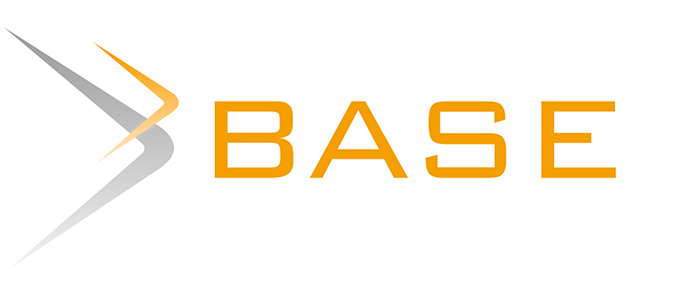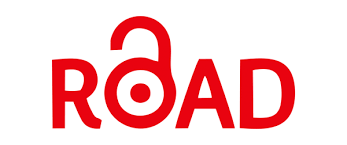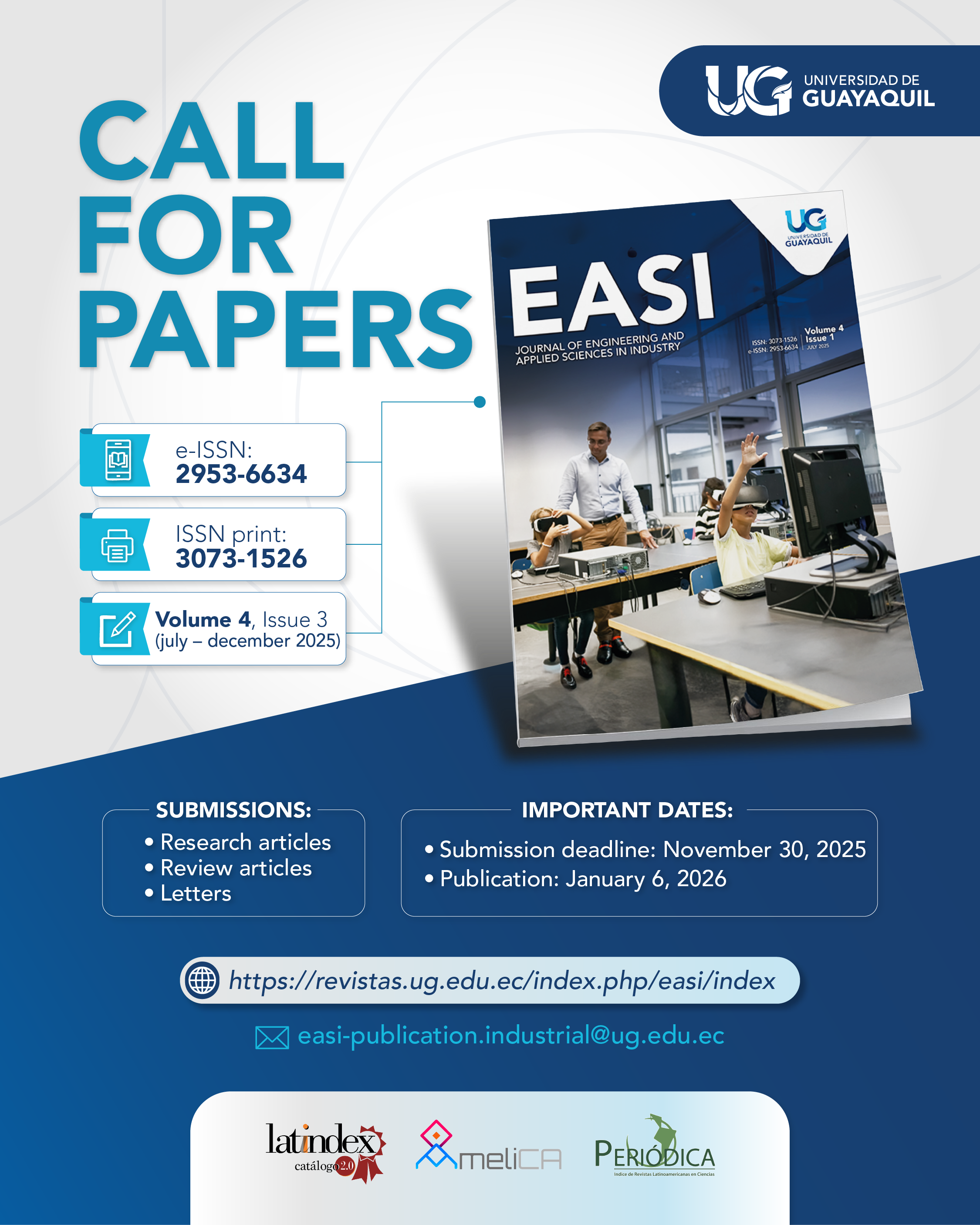Comparación del rendimiento de los procesos de pirolisis del PET, LDPE y PS, en un reactor prototipo de proceso discontinuo
DOI:
https://doi.org/10.53591/easi.v3i2.1866Palabras clave:
Pirólisis de plásticos, Hidrocarburos Líquidos, Reactor, Plástico, Factores Cr´ticosResumen
This document-template provides detailed instructions for preparing and submitting a paper Abstract. In this study, the critical factors of the pyrolysis process of plastics to obtain liquid hydrocarbons derived from petroleum were determined. The evaluation of these factors consisted of tests at specific temperatures of 350, 395 and 400°C using different types of plastics, such as polyethylene terephthalate (PET), polystyrene (PS) and low-density polyethylene (LDPE). The tests were carried out in a batch reactor with an average reaction time of 10 minutes. It was found that PS, processed at 395°C for 8 minutes, produced the highest number of liquid hydrocarbons, with an average yield of 91% by weight compared to the liquid products. In contrast, PET generated less than 30% of the product, while LDPE achieved a yield of 84%. The determining factors were the average temperature, the thermal insulation of the reactor and the selection of the type of plastic. Other factors, such as pressure and reaction rate, also proved to have a relevant impact on the process results.
Referencias
Abbas-Abadi, M. S., Haghighi, M. N., & Yeganeh, H. (2013). Evaluation of pyrolysis product of virgin high-density polyethylene degradation using different process parameters in a stirred reactor. Fuel Processing Technology, 109, 90-95. https://doi.org/10.1016/j.fuproc.2012.10.018
Aguilar Carlos (2019). Repositorio institucional: Universidad de los Andes, Colombia. Obtenido de https://repositorio.uniandes.edu.co/server/api/core/bitstreams/e25211a1-f669-499d-b1ee-c385dae9d6c5/content
Borrelle, S. B., Ringma, J., & Rochman, C. M. (2020). Predicted growth in plastic waste exceeds efforts to mitigate plastic pollution. Science, 369(6510), 1515-1518. https://doi.org/10.1126/science.aba3656
Castro-Verdezoto, P-, Vidoza J., Galo, W. (2019). Analysis and projection of energy consumption in Ecuador: Energy efficiency policies in the transportation sector. Energy Policy, 134, 110948. https://doi.org/10.1016/j.enpol.2019.110948
Castro, P., Da Cunha, M., García, A., Quintero, W. (2024). Energy policy implications of Ecuador’s NDC. Journal of Infrastructure, Policy and Development 2024, 8(13), 7542. https://doi.org/10.24294/jipd7542
Cruz, J. F., & Pulgarin, A. C. (2019, diciembre 15). Impacto del reciclaje en la biodiversidad. ANZOO. http://anzoo.org/publicaciones/index.php/anzoo/issue/view/11/RCZ%20Vol%20 5%20%2310
Ding, K., Liu, S., Huang, Y., Liu, S., Zhou, N., Peng, P., & Ruan, R. (2019). Catalytic microwave-assisted pyrolysis of plastic waste over NiO and HY for gasoline-range hydrocarbons production. Energy Conversion and Management, 196, 130-137. https://doi.org/10.1016/j.enconman.2019.06.076
Elordi, G., Olazar, M., Castaño, P., Artetxe, M., & Bilbao, J. (2012). Polyethylene cracking on a spent FCC catalyst in a conical spouted bed. Industrial & Engineering Chemistry Research, 51(40), 12816-12824. https://doi.org/10.1021/ie3018274
Espinoza, J. Naranjo, T. (2014). Diseño de una planta de reciclaje de plásticos en Cuenca. Universidad Politécnica Salesiana. https://dspace.ups.edu.ec/bitstream/123456789/7014/1/UPS-CT003680.pdf
Erdogan, S., & Sinan, S. (2020). Recycling of waste plastics into pyrolytic fuels and their use in IC engines. IntechOpen. https://doi.org/10.5772/intechopen.90639
Jahirul, M., Faisal, F., Rasul, M., Schaller, D., Khan, M., & Dexter, R. (2022). Automobile fuels (diesel and petrol) from plastic pyrolysis oil—Production and characterisation. Energy Reports, 8, 1571-1581. https://doi.org/10.1016/j.egyr.2022.10.018
Jung, S.-H., Cho, M.-H., Kang, B.-S., & Kim, J.-S. (2010). Pyrolysis of a fraction of waste polypropylene and polyethylene for the recovery of BTX aromatics using a fluidized bed reactor. Fuel Processing Technology, 91(3), 277–284. https://doi.org/10.1016/j.fuproc.2009.10.009
Klug, M. (2012). Pirólisis, un proceso para derretir la biomasa. Professional Engineering Publishers. https://revistas.pucp.edu.pe/index.php/quimica/article/view/5547
Krishna Moorthy Rajendran, V. C. (2020). Review of catalyst materials in achieving the liquid hydrocarbon fuels from municipal mixed plastic waste (MMPW). Science of the Total Environment, 733, 139101. https://doi.org/10.1016/j.scitotenv.2020.139101
López, A., Marco, I., Caballero, B., Laresgoiti, M., & Adrados, A. (2011). Dechlorination of fuels in pyrolysis of PVC containing plastic wastes. Fuel Processing Technology, 92(2), 253–260. https://doi.org/10.1016/j.fuproc.2010.10.011
Magaña, R. C., & Suárez, C. T. (2006, enero). Análisis del impacto ambiental de los plásticos en México. http://ri.uaemex.mx/bitstream/handle/20.500.11799/104205/secme16867_6.pdf?sequence=6&isAllowed=y
Miandad, R., Barakat, M., Aburiazaiza, A. S., Rehan, M., & Nizami, A. S. (2016). Plastic waste management: A review of pyrolysis technologies. Process Safety and Environmental Protection, 102, 822–838. https://doi.org/10.1016/j.psep.2016.06.022
Muley, P. D., Henkel, C., Abdollahi, K. K., & Boldor, D. (2015). Pyrolysis and catalytic upgrading of pinewood sawdust using an induction heating reactor. Energy & Fuels, 29(12), 8056–8065. https://doi.org/10.1021/acs.energyfuels.5b01878
Ndiaye, N., Derkyi, N., & Amankwah, E. (2023). Pyrolysis of plastic waste into diesel engine-grade oil. Scientific African, 21, e01547. https://doi.org/10.1016/j.sciaf.2023.e01547
ONU. (2022). Noticias ONU: Plásticos y medio ambiente. Obtenido de https://news.un.org/es/story/2022/06/1509892
Park, C., Kim, S., Kwon, Y., & Jeong, C. (2020). Pyrolysis of polyethylene terephthalate over carbon-supported Pd catalyst. Catalysts, 10(5), 496. https://doi.org/10.3390/catal10050496
Rahman, M. H., Bhoi, P. R., & Menezes, P. L. (2023). Pyrolysis of waste plastics into fuels and chemicals: A review. Renewable and Sustainable Energy Reviews, 180, 133135. https://doi.org/10.1016/j.rser.2023.133135
Rajendran, K. M., Chintala, V., Sharma, A., Pal, S., Pandey, J. K., & Ghodke, P. (2020). Review of catalyst materials in achieving the liquid hydrocarbon fuels from municipal mixed plastic waste (MMPW). Materials Today: Communications, 22, 100708. https://doi.org/10.1016/j.mtcomm.2020.100708
Sharuddin, S. D., Abnisa, F., Daud, W. M., & Aroua, M. K. (2016). A review on pyrolysis of plastic wastes. Energy Conversion and Management, 115, 308–326. https://doi.org/10.1016/j.enconman.2016.02.037
Subhashini, S., & Mondal, T. (2023). Experimental investigation on slow thermal pyrolysis of real-world plastic wastes in a fixed bed reactor to obtain aromatic rich fuel grade liquid oil. Journal of Environmental Management, 343, 118184. https://doi.org/10.1016/j.jenvman.2023.118184
Walker, T. R., & Fequet, L. (2023). Current trends of unsustainable plastic production and micro(nano)plastic pollution. TrAC Trends in Analytical Chemistry, 163, 117037. https://doi.org/10.1016/j.trac.2023.117037
Williams, P. T., & Slaney, E. (2007). Analysis of products from the pyrolysis and liquefaction of single plastics and waste plastic mixtures. Resources, Conservation and Recycling, 51(4), 754–769. https://doi.org/10.1016/j.resconrec.2006.12.002
Wong, S., Ngadi, N., Abdullah, T., & Inuwa, I. (2015). Current state and future prospects of plastic waste as a source of fuel: A review. Renewable and Sustainable Energy Reviews, 50, 1167–1180. https://doi.org/10.1016/j.rser.2015.04.063
Descargas
Publicado
Número
Sección
Licencia
Derechos de autor 2025 Jorge Torres, Milton Vinces, Pedro Castro, Jaime Arias

Esta obra está bajo una licencia internacional Creative Commons Atribución-NoComercial-SinDerivadas 4.0.
Las contribuciones publicadas en la revista EASI se rigen por la licencia de acceso abierto CC BY-NC-ND 4.0 (Creative Commons Reconocimiento-NoComercial-SinDerivadas 4.0). Esta licencia te empodera como autor, y garantiza la amplia difusión de tu investigación mientras protege tus derechos.
Para autores:
- Los autores pueden reproducir y distribuir la obra en cualquier formato no comercial, siempre que la obra indique los autores y datos de la revista EASI, y no contravenga los puntos mencionados en el apartado de los permisos y prácticas editoriales.
- La revista obtiene una licencia para publicar y distribuir el manuscrito original.
Para lectores/usuarios:
Acceso y distribución gratuita: cualquier lector o usuario puede acceder, descargar, copiar, imprimir y compartir el artículo publicado libremente según los términos de la licencia CC BY-NC-ND 4.0.
Reconocimiento obligatorio: si un tercero utiliza el material publicado, debe dar crédito al creador proporcionando el nombre, el título del artículo y el nombre de la revista, lo que garantiza la propiedad intelectual del autor(es) y ayuda a construir su reputación académica.
Uso no comercial: solo se permite el uso no comercial del trabajo publicado. No comercial significa que no está destinado principalmente ni dirigido al aprovechamiento comercial o la compensación monetaria por parte de ningún tercero.
No se permiten modificaciones: el contenido del artículo publicado no se puede cambiar, mezclar o reconstruir a partir del trabajo del autor. Esto asegura la integridad y precisión de los resultados de la investigación.









